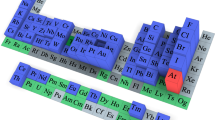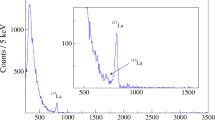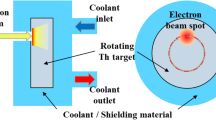Abstract
In 1957 Vester1 suggested that the then recently discovered2,3 violation of parity in weak interactions might be ultimately responsible for the present unique chirality of asymmetric molecules in the biosphere. Since then there has been a growing number of investigations involving the longitudinally polarised electrons from natural β decay. Initial attempts4,5 to detect asymmetric effects in several synthetic and degradative organic reactions using a number of β emitters failed and it was not until 1968 that Garay reported6 that β radiation from 90Sr/90Y caused D-tyrosine to degrade more than L-tyrosine in alkaline aqueous solution. Studies have subsequently looked at the possible asymmetric interaction of β rays (or their bremsstrah-lung) from a variety of sources (for example 104Rh (ref. 7), 90Sr/90Y (refs 8,9), 14C (refs 10–12) 32P (ref. 13) and polarised electrons from an accelerator14,15) with a number of racemic or optically active substrates (usually amino acids). Conflicting results emerging from these and certain related experiments have been tabulated13. Perhaps the most striking positive report among these studies is the claim by Darge and coworkers13 that D,L-tryptophan (4.9 × 10−7 mol in 2 ml frozen (−25°C) aqueous solution) was 33% decomposed with a 19% relative enrichment of the D-enantiomer in the undestroyed residue by the action during 12 weeks of the β rays from 5 mCi of co-dissolved 32P phosphate. The 33% gross decomposition was estimated from the UV absorption spectrum, and the 19% optical enrichment from the optical activity of the crude diluted reaction mixture, as compared with L-tryptophan at the same concentration (∼10−5M). The observed optical rotations used in the latter calculation were minute, −0.0036° for L-tryptophan and +0.0007° ±0.0004° (average of 16 observations) for the crude diluted reaction mixture. Because the remarkably large asymmetric effect claimed was based solely on these small observed rotations, and as the results have already been used by others in additional calculations16, we thought it desirable to attempt to duplicate the observations of Darge et al.13. We report here the use of a different analytical technique to estimate the enantiomeric composition of the undecomposed residual tryptophan, namely, gas chromatography (GC). The significant advantages of GC over optical rotation for determining the enantiomeric composition of small amounts of an optically active component admixed with impurities have already been described17.
This is a preview of subscription content, access via your institution
Access options
Subscribe to this journal
Receive 51 print issues and online access
$199.00 per year
only $3.90 per issue
Buy this article
- Purchase on Springer Link
- Instant access to full article PDF
Prices may be subject to local taxes which are calculated during checkout
Similar content being viewed by others
References
Vester, F., seminar, Yale Univ., 7 Feb. (1957).
Lee, T. D. & Yang, C. N. Phys. Rev. 104, 254 (1956).
Wu, C. S. et al. Phys. Rev. 105, 1413 (1957).
Vester, F., Ulbricht, T. L. V. & Krauch, H. Naturwissenschaften, 46, 68 (1959).
Ulbricht, T. L. V. & Vester, F. Tetrahedron 18, 629 (1962).
Garay, A. S. Nature 219, 338 (1968).
Goldanskii, V. I. & Khrapov, V. V. Sov. Phys. JETP 16(3), 582 (1963).
Bonner, W. A. J. molec. Evolut., 4, 23 (1974).
Bonner, W. A. & Flores, J. J. Origins of Life 6, 187 (1975).
Bernstein, W. J., Lemmon, R. M. & Calvin, M. in Molecular Evolution: Prebiological and Biological (eds Rolfing, D. L. & Oparin, A. I) 151 (Plenum, New York, 1972).
Noyes, H. P., Bonner, W. A. & Tomlin, J. A. Origins of Life 8, 21 (1977).
Bonner, W. A., Lemmon, R. M. & Noyes, H. P. J. org. Chem. 43, 522 (1978).
Darge, W., Laczko, I. & Thiemann, W. Nature 261, 522 (1976).
Bonner, W. A., Van Dort, M. A. & Yearian, M. R. Nature 258, 419 (1975); 264, 198 (1976).
Bonner, W. A., Van Dort, M. A., Yearian, M. R., Zeman, H. D. & Li, G. C. Israel J. Chem. 15, 89 (1976/77).
Keszthelyi, L. Origins of Life 8, 299 (1977).
Bonner, W. A., Van Dort, M. A. & Flores, J. J. Analyt. Chem. 46, 2104 (1974).
Bonner, W. A. J. Chromat. Sci. 11, 101 (1973).
Bonner, W. A. & Blair, N. E. J. Chromat. 169, 153 (1979).
Author information
Authors and Affiliations
Rights and permissions
About this article
Cite this article
Bonner, W., Blair, N. & Flores, J. Attempted asymmetric radiolysis of D,L-tryptophan with 32P β radiation. Nature 281, 150–151 (1979). https://doi.org/10.1038/281150a0
Received:
Accepted:
Issue Date:
DOI: https://doi.org/10.1038/281150a0
Comments
By submitting a comment you agree to abide by our Terms and Community Guidelines. If you find something abusive or that does not comply with our terms or guidelines please flag it as inappropriate.



